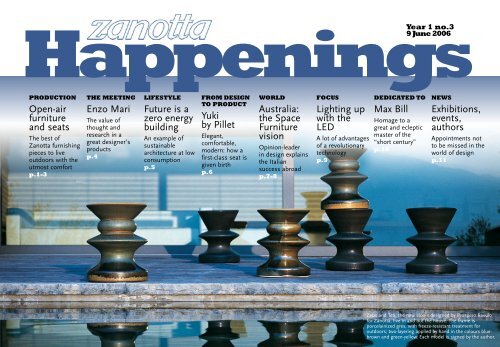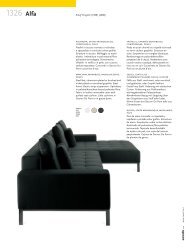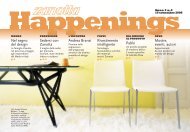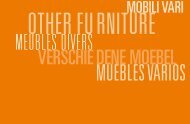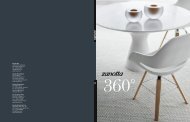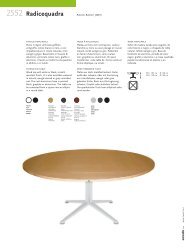Happenings - Zanotta SpA
Happenings - Zanotta SpA
Happenings - Zanotta SpA
You also want an ePaper? Increase the reach of your titles
YUMPU automatically turns print PDFs into web optimized ePapers that Google loves.
<strong>Happenings</strong><br />
Year 1 no.3<br />
9 June 2006<br />
PRODUCTION<br />
Open-air<br />
furniture<br />
and seats<br />
The best of<br />
<strong>Zanotta</strong> furnishing<br />
pieces to live<br />
outdoors with the<br />
utmost comfort<br />
p.1-3<br />
THE MEETING<br />
Enzo Mari<br />
The value of<br />
thought and<br />
research in a<br />
great designer’s<br />
products<br />
p.4<br />
LIFESTYLE<br />
Future is a<br />
zero energy<br />
building<br />
An example of<br />
sustainable<br />
architecture at low<br />
consumption<br />
p.5<br />
FROM DESIGN<br />
TO PRODUCT<br />
Yuki<br />
by Pillet<br />
Elegant,<br />
comfortable,<br />
modern: how a<br />
first-class seat is<br />
given birth<br />
p.6<br />
WORLD<br />
Australia:<br />
the Space<br />
Furniture<br />
vision<br />
Opinion-leader<br />
in design explains<br />
the Italian<br />
success abroad<br />
p.7-8<br />
FOCUS<br />
Lighting up<br />
with the<br />
LED<br />
A lot of advantages<br />
of a revolutionary<br />
technology<br />
p.9<br />
DEDICATED TO<br />
Max Bill<br />
Homage to a<br />
great and ecleptic<br />
master of the<br />
“short century”<br />
p.10<br />
NEWS<br />
Exhibitions,<br />
events,<br />
authors<br />
Appointments not<br />
to be missed in the<br />
world of design<br />
p.11<br />
Zeus and Teti, the new stools designed by Prospero Rasulo<br />
for <strong>Zanotta</strong>, live in and out the house. The frame is<br />
porcelainized gres, with freeze-resistant treatment for<br />
outdoors; two-layering applied by hand in the colours bluebrown<br />
and green-yellow. Each model is signed by the author.
PRODUCTION<br />
Open-air<br />
New materials and simple shapes to live outdoors<br />
with the utmost comfort. Quality signed by <strong>Zanotta</strong><br />
On the terrace, between the living room and the garden, at the<br />
pool sides. Free to enter the living room as well, thanks to the<br />
basic design and the noble materials. The furniture and seats<br />
proposed by <strong>Zanotta</strong> to decorate the outdoors spaces create conversation<br />
corners and comfortable relax areas, both elegant and functional.<br />
Among the brand new and weather-proof materials: carbon fibre of the<br />
aerodynamic Fly, the decorated polyethylene with rotationmoulding<br />
technique of Dora armchair, the aluminium painted with a special antioxidizing<br />
lacquer and the techno fabric of Zilli chair, the aluminium matching<br />
the polypropylene sling, reinforced with glass fibre for the Isa chair.<br />
In addition to these we find the scratch-resistant finish of Brasilia lounge<br />
chair, made of structural hard polyurethane. Among the best materials for<br />
outdoors we mention: oil-treated teak for the demountable and folding<br />
Extra table; the 18/8 stainless steel for the Sun small bed and the painted<br />
for outdoors steel for the Grillo table base. In the end an ironic revival<br />
from the Sixties: the spider-shaped legs of Allunaggio, the seat signed by<br />
Achille and Pier Giacomo Castiglioni in 1965 that is still in production.<br />
SUN by For Use,<br />
2003. Small bed.<br />
18/8 stainless steel<br />
frame. Removable<br />
cover in Vela fabric<br />
for outdoors use.<br />
Upon request,<br />
seat cushion in<br />
polyurethane/Dacron<br />
Du Pont with fabric<br />
cover. Just a simple<br />
movement will shift<br />
the back into two<br />
different positions.<br />
DORA by Ludovica and Roberto Palomba, 2005.<br />
Armchair. Polyethylene frame for outdoors, plain<br />
coloured with floral decorations in white,<br />
aluminium, beige or black. Also available glossy<br />
lacquered in white, red, brown or black.<br />
<strong>Happenings</strong><br />
no.3/06 p.2<br />
ZILLI by Roberto<br />
Barbieri, 2002.<br />
Stackable chair with<br />
polished or painted<br />
Aluminium alloy<br />
frame for outdoors.<br />
Seat and back are<br />
of weather-proof<br />
fabric Vela,<br />
or polyurethaneupholstered<br />
and covered<br />
with Ecopelle or<br />
leather 95.<br />
GRILLO by Roberto Barbieri, 2004. Coffee table. Steel legs<br />
varnished black, white, aluminium or red for outdoors. Plate<br />
glass tops varnished red or black, or in extra-clear tempered<br />
plate glass varnished aluminium, or in medium density<br />
fiberboard, veneered in bleached or wengé - stained oak or<br />
layered laminate top, colour white or black.
<strong>Happenings</strong><br />
no.3/06 p.3<br />
ALLUNAGGIO by Achille and<br />
Pier Giacomo Castiglioni, 1965.<br />
Outdoors seat. Steel legs and<br />
aluminium alloy seat, painted<br />
grass green or aluminium.<br />
Polyethylene feet, natural colour.<br />
ISA by R. Barbieri, 2004. Chair.<br />
Aluminium alloy frame, polished<br />
or varnished aluminium, white or<br />
black for outdoors. Polypropylene<br />
sling reinforced with co-injected<br />
glass fibre for outdoors, matt<br />
finish in white or light grey, or<br />
painted aluminium, red or black<br />
for outdoors (combined with<br />
stain-resistant cowhide).<br />
BRASILIA by Ross<br />
Lovegrove, 2003.<br />
Lounge chair. The two<br />
elements, armchair<br />
and pouf are made<br />
of structural hard<br />
polyurethane, painted<br />
with scratch-resistant<br />
finish. Available in<br />
white or in the<br />
colours of our<br />
colour-card.<br />
FLY by Mark Robson, 2002. Stackable seat.<br />
Clear varnished carbon fibre frame. Cover in<br />
elastic polyester Quota fabric.<br />
EXTRA by For Use, 2003.<br />
Demountable and folding<br />
table. Stainless steel 18/8<br />
frame. Layered laminate<br />
top, colours white or black,<br />
or in teak treated with oil<br />
for outdoors use.
<strong>Happenings</strong><br />
no.3/06 p.4<br />
Possible Projects<br />
THE MEETING<br />
Enzo Mari. One of <strong>Zanotta</strong>’s most<br />
famous collaborators relates his idea<br />
of design starting from a seat<br />
In 1980 Aurelio <strong>Zanotta</strong> paid Enzo<br />
Mari a visit with a 6th degree<br />
rock climber’s nail, the type that<br />
makes the most of crevices in the rock<br />
wall to sustain the climber’s body.<br />
This was the beginning of project<br />
Tonietta, <strong>Zanotta</strong>’s seat, which won<br />
the Compasso d’Oro award in 1987.<br />
Its designer, architect Enzo Mari,<br />
speaks about it.<br />
Q. What lies at the basis of your<br />
projects?<br />
A. Let me give you an example. During<br />
the same years, Cesare Cassina too<br />
was reasoning on the idea of the rock<br />
climber’s nail (he was a mountain<br />
enthusiast). He thought of having<br />
them produced in forged aluminium,<br />
which is highly compressed and very<br />
strong. Instead, starting from<br />
Aurelio’s idea I thought of making the<br />
chair’s legs in die-cast aluminium with<br />
differentiated thicknesses and thinner,<br />
slightly curved front legs. It took me<br />
five years to reach the right thickness<br />
and the final design. The assistance of<br />
Penati (Head of <strong>Zanotta</strong>’s Technical<br />
Department at the time) with whom I<br />
defined every detail to make Tonietta<br />
work perfectly was essential. I cannot<br />
stand projects that are conceived the<br />
same morning as I cannot tolerate<br />
those who come along asking for an<br />
idea for the next day… You need<br />
thought, research and work to reach a<br />
design and create a product. The only<br />
possible reasons to design an item<br />
issue from the intention to clearly<br />
communicate a shape and the chair is<br />
the simplest shape one can start<br />
from: it has four legs, a seat and a<br />
back. Tonietta’s pure arch and strong<br />
thin legs. The assembly system recalls<br />
that of the historical Thonet.<br />
The effort focuses on gaining the<br />
utmost resistance with the minimum<br />
use of material.<br />
Q. After Tonietta, you designed many<br />
other furniture items and accessories<br />
for <strong>Zanotta</strong> - all characterised by<br />
remarkable formal purity, functionality<br />
and an advanced technological layout.<br />
Which do you recall with most<br />
satisfaction?<br />
A. I recall them all. The coffee table<br />
Ambo with crystal tops - in practise it<br />
comprises two coffee tables, one low<br />
and one high, designed to be fitted<br />
as the user pleases. The table<br />
Dongiovanni, whose legs joined at the<br />
top with a special star-shaped joint<br />
designed by me. And then the seat<br />
Marina, the clothes hanger Museo,<br />
the table Fonte and the upholstered<br />
items Daniele. I do not like creating<br />
products for the market. I like to think<br />
of formal beauty and how to<br />
concretise it by rationalising the<br />
production process.<br />
Q. Which customer target do you<br />
have in mind when you create a piece<br />
of furniture?<br />
A. On the forty million potential<br />
purchasers of furnishing items in Italy,<br />
I think very few can draw close to<br />
design today. And it is not merely a<br />
matter of IQ… The first approach<br />
should be financial and, economy<br />
leads to basics. I find classical Greek<br />
culture’s manner of proceeding ideal.<br />
Rather than needs, I want to focus on<br />
defending the right to think.<br />
Six variations<br />
of the chair<br />
Tonietta.
LIFESTYLE<br />
<strong>Happenings</strong><br />
no.3/06 p.5<br />
The decision to build new settlements - often<br />
around a considerably old nucleus (the village<br />
we wish to discuss dates back to 1500) - in<br />
landscapes that are not unlike the Italian hill<br />
and lake country is rather frequent. The solution for such<br />
settlements could be terraced houses enhanced by a<br />
radical novelty: sustainable energy. We are in the town<br />
Affoltern am Albis, Switzerland, between Zug and Zurich<br />
on A road 9. It counts 10,000 inhabitants and the mayor is<br />
a woman. On land located a few hundred meters from the<br />
cantonal road, uneven land at the foot of the hills, which<br />
separate Affoltern from lake Zurich, stands a complex of<br />
terraced houses, which even at a distance make us<br />
perceive that something different has been conceived. The<br />
houses are not too far apart - which reveals focus on good<br />
neighbourly relations -, volumes are simple, the use of<br />
unprocessed wood is evident, balconies are spacious and<br />
there are solar panels. Ten terraced complexes numbering<br />
four homes each have a 10,000 sq.mt. total living surface<br />
area. Though the urban layout is thick, interiors are<br />
spacious: all homes are designed on 6 metre modules<br />
with the same layout but variable surface area and number<br />
of floors. All have three floors: some with a basement and<br />
others with three floors above ground level. But the most<br />
relevant features do not catch the eye instantly. Each<br />
house is modulated on both an active and passive use of<br />
solar energy: main entrances and bathrooms are located<br />
in such a way as to liven up internal spaces to create<br />
varying tracks for sunlight. The kitchen and entrance are<br />
separated by a glass wall designed to increase the effect of<br />
transparency, full-length glass windows in bathrooms<br />
overlook the landscape and balconies on every floor<br />
expand space and shield the sitting-room and bedrooms<br />
from direct sunlight. Every home is arranged for the<br />
installation of solar panels to heat hot water. Heating<br />
instead is based on a heat pump, which makes use of the<br />
thermal contribution of underground waters by means of<br />
10 cm pipes that extend for a length of 180 metres. This<br />
heating method removes the use of all types of fuel.<br />
Global consumption complies with the best indexes<br />
established by the recent European law concerning<br />
buildings’ energy certification: 51 kWh/sq.mt./year. It is<br />
one of the best high end products. Houses in Looren<br />
stand on concrete foundations, but the rest of the<br />
structure is in wood. The colour of deal is touching and<br />
warm - local red spruce and Douglas spruce! They are left<br />
natural with neither finishes nor preservative treatment.<br />
The flat roof is covered by a ca. 10 cm vegetable layer: in<br />
case of strong rain the layer holds part of the rain water,<br />
slowly releasing it into a stream which runs through the<br />
settlement. There is greenery everywhere with birds and<br />
small woodland mammals. The municipal swimming-pool<br />
is not very distant and it is free of charge; the football<br />
team is not listed in the stock exchange and winter snow<br />
invites to do cross-country skiing. In good weather one<br />
goes running with an ipod in the pocket.<br />
Assembled wooden frame for the ecologic building designed by Metron.<br />
The<br />
zero-energy<br />
future<br />
The housing complex based on<br />
terraced houses in Looren, Affoltern<br />
am Albis, Switzerland, is an<br />
exemplary case of sustainable low<br />
consumption architecture. Project<br />
Metron’s research has focused on<br />
optimising energy, ecological<br />
features and high living standards
<strong>Happenings</strong><br />
no.3/06 p.6<br />
FROM DESIGN TO PRODUCT<br />
Sober flowing lines distinguish<br />
Christophe Pillet’s new Yuki<br />
CHRISTOPHE PILLET<br />
He attended the Institute of<br />
Decorative arts, Nice, and<br />
graduated in industrial design at<br />
the Domus Academy of Milan.<br />
He worked with Philippe Stark in<br />
Paris till ’93. In ’94 he was<br />
acclaimed the French Createur<br />
de l’année, hence many<br />
exhibitions were dedicated to<br />
him both at the Centre<br />
Pompidou and at the Villette.<br />
Today luxury is removal of the<br />
superfluous.» Christophe Pillet, the<br />
famous French designer, adopts<br />
this paradigm to sum up his vision<br />
of the project. His idea of available “luxury”<br />
(considered as a combination of top quality<br />
furniture and items) is based on the use both<br />
of new technologies and materials, which can<br />
best apply to them. «I do not wish to sound<br />
like an elitist minimalist - he adds - but I mean<br />
to convey the need to produce elements that<br />
are both simple and refined for timeless<br />
contemporary homes.» Yuki, his armchair for<br />
Praise to<br />
simplicity<br />
<strong>Zanotta</strong>, is an example of this concept - a firm<br />
rotating varnished steel base with four legs<br />
converging onto a single central joint and a<br />
flowing hollow stiff polyurethane unitised<br />
body, which holds padded cushions<br />
upholstered with removable fabric or leather.<br />
«I designed Yuki with CAD following a line<br />
that is dear to me: a cosy rounded seat fitted<br />
to a central pin. <strong>Zanotta</strong>’s staff instantly liked<br />
the model and I refined the details with them<br />
by e-mail. It was all very easy and we soon<br />
created the prototype, which was virtually<br />
perfect. Every step was checked with the<br />
technical team and perfected without hitches<br />
as, for instance, the choice of the right density<br />
for the polyurethane sheet, which had to be<br />
both solid and flexible: <strong>Zanotta</strong> succeeded in<br />
realising this wish of mine. Yuki’s first version<br />
had a more “playful” design that was almost<br />
pop; its evolution was more classical and the<br />
last leather upholstered version achieved a<br />
highly refined result». The “elective” affinity<br />
between Pillet and <strong>Zanotta</strong> was the starting<br />
point to achieve quality production in optimal<br />
times. «I always decide to work with firms I<br />
have an instant understanding with. This<br />
occurred with <strong>Zanotta</strong> and with the firms<br />
producing accessories and complements for<br />
cars that preceded it. Yuki was the result of a<br />
study track I began with my previous chair -<br />
Y’s - to which I applied modern car seat<br />
technology for the first time (I have worked for<br />
years for Renault). I like to investigate<br />
different worlds to convey and merge technical<br />
findings. I have designed taps starting from<br />
hifi and microwave oven ignition systems,<br />
which exploit the technology used for thermal<br />
glass casseroles». Pillet’s study involves<br />
experts for every detail, ranging from the<br />
unitised body of seats to fabric seams, from<br />
electronic systems to ergonomic ones and<br />
from ophthalmology to computer science. It is<br />
the so-called “Starck system”, which the<br />
French designer learnt when he worked with<br />
his colleague and which he refined in the USA<br />
and in Japan. «My next dream? To create a<br />
design, which offers people an alternative<br />
lifestyle in terms of wellness and happiness».<br />
Portrait of the designer and CAD drawing of the<br />
armchair Yuki designed for <strong>Zanotta</strong>
<strong>Happenings</strong><br />
no.3/06 p.7<br />
WORLD<br />
XXI Century<br />
design<br />
Space Furniture, leader in the Australian<br />
market, expresses a different voice<br />
Aconversation with<br />
Kevin Jarrett,<br />
founder and<br />
chairman of Space<br />
Furniture showrooms,<br />
between Sydney, Brisbane,<br />
Singapore and London. The<br />
one located in Sydney is the<br />
most important design store<br />
of the continent.<br />
Q. How is going the<br />
Australian furniture market<br />
and how they appreciate<br />
Italian design in your country?<br />
A. In the last 5 years we have<br />
seen growth of over 25% per<br />
year. Design furniture has had<br />
more exposure in the last 5<br />
years and companies like<br />
Space have done more to<br />
promote design with the<br />
invitations of many Italian<br />
guests to Australia further<br />
helping to promote the<br />
market. This has also been<br />
helped by architects designing<br />
interiors for high end real<br />
estate, houses and<br />
apartments.<br />
Q. Speaking about life style in<br />
Australia, do you think there<br />
will be an increasing attention<br />
on design? And, what kind of<br />
design? Modern or more<br />
classic?<br />
A. Lifestyle in Australia<br />
revolves around the<br />
contemporary, our climate is<br />
mainly warm and promotes<br />
outside living which has an<br />
emphasis on modern interiors<br />
rather than classic traditional<br />
interiors.<br />
Q. Do they know well Italian<br />
“griffes” in design and fashion<br />
in your cities? Or do they give<br />
more importance to furniture<br />
and materials quality?<br />
A. We have seen an increase of<br />
awareness in Italian lifestyle<br />
products. Italian design of<br />
fashion, furniture, interior<br />
products is much more of a<br />
way of life and people are<br />
starting to appreciate the<br />
value in good design. Where<br />
we see, not so much of an<br />
increase for e.g. is in the UK<br />
where Italian furniture design<br />
is quite low compared to the<br />
population. Australians are<br />
becoming more sophisticated<br />
KEVIN JARRETT<br />
1993 opens the first Space<br />
Furniture in Sydney, that acts as<br />
spring board for the best<br />
interior design companies in<br />
Australia and Asian South-East.<br />
2001 three new showrooms<br />
were open: in London, Brisbane<br />
and Singapore. 2003 he<br />
establishes the magazine More<br />
Space, a prestigious stage for<br />
the contemporary life-styles.<br />
with Made in Italy products at<br />
a higher level.<br />
Q. You have a very interesting<br />
magazine, More Space, what<br />
are its target and aims?<br />
A. My philosophy behind More<br />
Space is to “create a<br />
difference” - an edgy<br />
communication which is more<br />
about the design process than<br />
the product. Any publisher can<br />
produce another architectural<br />
digest, Casa Vogue etc. We<br />
don’t want to do that as More<br />
Space is a philosophy on<br />
communicating good design<br />
in a different way. I would like<br />
The interiors of the first showroom<br />
opened by Jarrett in Sydney: 4000<br />
square meters on six spectacular floors.
to think that it has a difference<br />
and people want something<br />
different.<br />
Q. What would you like<br />
Italian designers and furniture<br />
industries would do to<br />
project and produce things<br />
answering to new<br />
requirements and needs for<br />
Australian way of living?<br />
A. To understand the<br />
Australian way of living we<br />
need to give them a brief, but<br />
what is the difference? We are<br />
like all hot climate countries<br />
that live on the coast. We are<br />
mainly casually people, not<br />
sophisticated like central<br />
European people. We have to<br />
appeal to clients that walk into<br />
our showroom in D&G jeans,<br />
sleeveless T-shorts wearing<br />
thongs on the weekend. My<br />
point is, that many of our<br />
customers live in “Billabong”<br />
clothes and live in very<br />
expensive houses. They want<br />
sophisticated products but in<br />
a relaxed way - this relaxed way<br />
should also be considered<br />
with very different fabrics as<br />
well, but more importantly<br />
products that have longevity<br />
and are unique in design. Our<br />
philosophy is “Furniture for<br />
Expressive personalities and<br />
lifestyles”. We are talking more<br />
and more to Italian<br />
designers as our market in<br />
Australia and Asia grows.<br />
Q. How do you feel working<br />
with Italian designers and<br />
architects, such as those who<br />
contributed in your Space’s<br />
adventures? What do you<br />
think is the principal<br />
difference between their<br />
“touch” and the one of other<br />
similar professional figures<br />
in the world?<br />
A. The most admirable<br />
features of the Italian<br />
architects and designers’ work<br />
(like Citterio and Lissoni, for<br />
instance, who have curated<br />
the project of our stores) is<br />
their understanding of the<br />
furniture industry. At this level<br />
of design/architecture, you<br />
must have a great business<br />
brain and actually help the<br />
businesses, not only by the<br />
collections they design, but<br />
also the contribution to<br />
develop the business with<br />
their collection. For example,<br />
they could take their collection<br />
into a hotel project or serviced<br />
apartments and they<br />
understand the way that the<br />
upholstery moulds are<br />
produced and they understand<br />
the research and development<br />
process. They don’t just give a<br />
sketch, they give drawings to<br />
develop the proper prototype<br />
and develop the market. Most<br />
of them are very affluent Art<br />
Directors of major companies.<br />
They understand the image<br />
clearly and where the brand is<br />
driven from. They don’t only<br />
just design a piece of<br />
industrial product.<br />
BEING ABLE TO COMMUNICATE<br />
More Space as conceived by<br />
Kevin Jarrett is a space to think<br />
about design and to communicate<br />
its evolution processes. It is also<br />
a special shop-window/story<br />
where ideas, images, witnesses<br />
of his favourite artists and<br />
designers are welcome:<br />
Ron Arad, Philippe Starck, Piero<br />
Lissoni, Antonio Citterio (who<br />
has taken care of setting up<br />
the Space Furniture shops<br />
together with John Pawson).<br />
Above, exteriors and interiors<br />
of the Sydney showroom.<br />
<strong>Happenings</strong><br />
no.2/06 p.8<br />
«Italian design of fashion,<br />
furniture, interior products is<br />
much more of a way of life»
FOCUS<br />
Lighting in a solid state will be the<br />
next “disruptive technology”.<br />
New alchemists for new lighting.<br />
<strong>Happenings</strong><br />
no.3/06 p.9<br />
New LED Technology: a challenge!<br />
In 1992 the Japanese Shuji Nakamura perfected the<br />
industrial production process of a minute<br />
electronic component (with just a few millimetres’<br />
surface) that issued weak blue light rays. It was the<br />
work of ten years, which cost three million dollars. Thus<br />
began, in a remote Japanese region famous for its spas<br />
and start up companies of solid state electronics, a<br />
production technology for light that was recently<br />
classified by the US Department for Development as<br />
“disruptive technology”, a devastating technology that<br />
will alter a sector of human activities at the very root. Few<br />
recall how things were before the advent of “containers”<br />
in the crucial transport sector. Something similar will<br />
occur in lighting too. Technologies for the creation of<br />
light in the solid state will provide the post-modern<br />
domestic and urban scene with light - even infrared light -<br />
with negligible dissipation of energy and heat and<br />
remarkable resistance to shock, vibrations, wear and tear.<br />
These “bulbs”, which function at a low voltage - often<br />
below 24 volts - could radically redefine the electrical<br />
safety of homes. The risk of electrocution caused by the<br />
use of alternate 220V current would also be less.<br />
LIGHT LIKE GOLD<br />
The L.E.D. - acronym for Light-Emitting Diode - is a<br />
“diode that issues light”. If ancient alchemists sought the<br />
way to knowledge amidst metals and if they anxiously<br />
sought the way to transmute a humble metal into a more<br />
noble one (gold seemed the best choice to many),<br />
modern technologists have found present day gold once<br />
again amidst metal: light, the real wealth of our age and<br />
the real essence of modernity. Today the value of a little<br />
block - just a few cubic centimetres large - of purified<br />
silica makes hundreds of chests full of gold coins grow<br />
pale. Produced in establishments based on “clean<br />
rooms”, environments in which air is constantly purified,<br />
LEDs are produced by processing small silica bars that<br />
have been treated in various manners. The result is a<br />
minute device made by combining a precious metal and<br />
a “non metal”. Controllable light radiation issues from<br />
their link up region when a weak current flows through it.<br />
THE CHANGES INSIDE<br />
There are two immediate consequences for both project<br />
planners and designers: extreme flexibility and<br />
manoeuvrability, a wide selection of shapes and control<br />
of both the flow and the colour of light. The firm instead<br />
enjoys significant energy saving and greater safety<br />
features. The advantages of LED-based lighting for living<br />
and public environments in the first instance number<br />
miniaturised light sources (clearly visible, they challenge<br />
projects and product designers) and the subsequent<br />
choice of multiple lighting for spectacular effects;<br />
secondly they involve long duration, reliability, saturated<br />
colour and the option to play with dynamic chromatisms.<br />
Combined with easy to programme control circuits,<br />
which are less bulky than a remote control, LEDs open<br />
the doors to new opportunities both for designers and<br />
buyers: the option of changing a light source’s quality,<br />
intensity and colour at a later date. Written with the<br />
collaboration of Flavio Vida.<br />
The new bulb leds by Philips match the various lamp types.
<strong>Happenings</strong><br />
no.3/06 p.10<br />
DEDICATED TO<br />
Max<br />
Bill<br />
Students on Max<br />
Bill’s “Stools” in<br />
classrooms at the<br />
School in Ulm<br />
(1951).<br />
Few architects have expressed the<br />
1900s as Max Bill did: he thought,<br />
spoke, wrote, designed and<br />
organised. Painter, sculptor,<br />
graphic designer, architect and<br />
philosopher, Bill was a member of<br />
international study and design<br />
groups. He studied with<br />
Kandinsky and Klee and moved<br />
with Le Corbusier, Duchamp,<br />
Eames, Mies Van Der Rohe and<br />
Rogers. Co-founder of the<br />
Superior Institute of Design in<br />
Ulm, in 1950 he created the Stool<br />
for the famous school - a wooden<br />
seat with a basic geometrical<br />
shape, whose design was virtually<br />
erased to the advantage of its<br />
function. It is to date produced by<br />
<strong>Zanotta</strong> (sponsor of the important<br />
exhibition on Max Bill’s work held<br />
in the Palazzo Reale, Milan, till<br />
25th June). Aurelio <strong>Zanotta</strong> gave<br />
the item its ironical name when<br />
he began its production.
NEWS<br />
Don’t miss it!<br />
Exhibitions, events, authors<br />
<strong>Happenings</strong><br />
no.3/06 p.11<br />
HAPPY VISIONS!<br />
With “Pyramid in the<br />
Pacific - Architectural and<br />
Geopolitical Ideas for the<br />
Ruins of Ryugyong Hotel<br />
in Pyongyang, North<br />
Korea”, Domus magazine<br />
introduced at the Milan<br />
Triennale the outcome of<br />
idea consultations<br />
launched in June 2005<br />
concerning the reuse of<br />
this incomplete 330 m<br />
high concrete building.<br />
120 projects and ideas<br />
from throughout the<br />
world suggest realistic,<br />
eccentric, brilliant and<br />
often provocative<br />
solutions to transform a<br />
symbol of the titanic<br />
power of despots into a<br />
new aerial for global<br />
communications. Along<br />
with these projects,<br />
Domus has just<br />
proposed original images<br />
of Pyongyang projected<br />
in a hall furnished with<br />
armchairs Sacco<br />
provided by <strong>Zanotta</strong> for<br />
the occasion.<br />
ZANOTTA AND XELION<br />
The 5th Xelion Financial<br />
Village, travelling kermis<br />
of <strong>Zanotta</strong> furnishings<br />
displayed in the halls of<br />
exclusive sites at meetings<br />
held in 2006, has set off<br />
from the Pistoletto<br />
Foundation in Biella.<br />
The new set of theme<br />
appointments on<br />
economic markets’ current<br />
scenes will focus especially<br />
on Xelion Advice, an<br />
innovative investment<br />
service. The meetings -<br />
open to the public and<br />
organised by UniCredit<br />
Xelion Banca - will touch<br />
eight laps in enchanting<br />
spots numbering Palazzo<br />
Corsini in Florence, the<br />
prestigious Ville Ponti<br />
Congress Centre in Varese,<br />
Villa Pignatelli in Naples,<br />
the Rancia castle in<br />
Tolentino, Santo Spirito in<br />
Saxia in Rome and the<br />
historical Hunting Lodge<br />
in Stupinigi. Last lap,<br />
Messina with its sea, and<br />
Sicilian gothic architecture.<br />
HISTORICAL SEATS<br />
AT THE MAK<br />
On 13th June an original<br />
review of “suspended”<br />
historical seats -<br />
“Cantilever Chairs” - will<br />
open at the Museum of<br />
Applied Arts and<br />
Contemporary Art in<br />
Vienna. 80 years of seating<br />
inventions based on the<br />
simple cantilever principle<br />
will be displayed, starting<br />
from the first tubular steel<br />
prototype presented by the<br />
famous Mart Stam in the<br />
’20s and numbering<br />
Marcel Breuer, Mies Van<br />
der Rohe and<br />
contemporary Tom Dixon<br />
and Ross Lovegrove.<br />
<strong>Zanotta</strong> - the sponsor - will<br />
participate in the exhibition<br />
with the seat Mezzadro<br />
designed by the Castiglioni<br />
brothers (design 1957):<br />
this unusual stool adds a<br />
touch of irony, the superb<br />
intuition of ergonomics<br />
and a still surprising<br />
flexibility to the original<br />
idea of suspended seat.<br />
DESIGN AND<br />
TECHNOLOGY<br />
Which technological<br />
innovations lead to present<br />
day furnishing products?<br />
How far do new materials<br />
influence contemporary<br />
décor? On these questions<br />
investigates the VIA /<br />
Industries Francaises de<br />
l’Ameublement with the<br />
exhibition set up in Paris:<br />
“Surfaces and Materials for<br />
Decorating and<br />
Personalizing”. As the<br />
curator Gerard Laize<br />
anticipates: «the birth of<br />
new materials, technologies<br />
and processes are opening<br />
inconceivable creative<br />
fields». <strong>Zanotta</strong><br />
participates in the event<br />
with two armchairs, which<br />
are the outcome of<br />
considerable research: the<br />
new Dora with floral<br />
decorations - by L. and R.<br />
Palomba - and the<br />
historical Sacco covered<br />
with Missoni Home’s Scilla<br />
fabric. Open till 25th June.<br />
ANNIVERSARIES<br />
Contemporary design has<br />
a privileged seat in Nimes,<br />
the French city that is<br />
famous for its wines and<br />
magnificent Roman<br />
amphitheatre: it is<br />
Domus, one of the<br />
region’s most exclusive<br />
showrooms, celebrating<br />
30 years of business with<br />
a historical retrospective<br />
on furnishings from 1976<br />
to 2006. «The mobilier<br />
d’architecte finds one of<br />
its most representative<br />
productions in <strong>Zanotta</strong>»,<br />
says Alain Recolin, patron<br />
of Domus and enthusiast<br />
promoter of meetings and<br />
events on the value and<br />
meaning of design. «This<br />
is my entire world. How<br />
can we fail to acknowledge<br />
design’s primary role of<br />
expression and cultural<br />
and social transference?».<br />
No. 11, Rue de l’Horloge,<br />
Nimes - 29 June - 31<br />
December. Cocktail on the<br />
29th from 6:00 pm.<br />
FREUD ON SHOW<br />
To celebrate 150 years from<br />
the birth of Prof. Freud,<br />
Prague and Vienna have<br />
organised two special<br />
exhibitions. In the famous<br />
psychoanalyst’s native city,<br />
the Sigmund Freud Museum<br />
has organised the exhibition<br />
“The Couch: Thinking in<br />
Repose” till 5th November.<br />
<strong>Zanotta</strong> is one of the event’s<br />
sponsors with the sofa Freud<br />
designed by Todd Bracher<br />
(2002). It is a homage to the<br />
famous sofa, now treasured<br />
at the Freud Museum,<br />
London, and which seated<br />
the great Austrian<br />
neurologist’s patients for<br />
numberless years. Happy<br />
Birthday, Dr. Freud!<br />
Editorial project Giuliana Zoppis<br />
Graphic design Stefania Giarlotta<br />
Coordination and supervision <strong>Zanotta</strong> spa<br />
Picture (p. 10) Georg Mayer/MAK<br />
Copyright <strong>Zanotta</strong> spa<br />
The use of texts and images are subject<br />
to <strong>Zanotta</strong> authorization<br />
Press office <strong>Zanotta</strong><br />
tel. 0362.4981<br />
www.zanotta.it<br />
communication@zanotta.it


